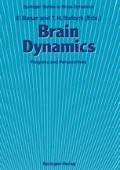Abstract
The investigation of brain electrical activity is usually approached in one of two ways. In the first approach the methods of analysis of stochastic signals are used to extract the characteristic features of the EEG, without any attempt to elucidate the physiological basis of its generation (Gersh and Yonemoto 1977; Gersh et al. 1977; Bodenstein and Praetorius 1977). In the second approach, models based on the neurophysiological data are created, but very often the results of the modeling are difficult to compare directly with the experimental data and only general features of the EEG are described (Aninos and Zenone 1980; Wilson and Cowan 1973; Zetterberg 1973).
Access this chapter
Tax calculation will be finalised at checkout
Purchases are for personal use only
Preview
Unable to display preview. Download preview PDF.
References
Aninos PA, Zenone S (1980) A neural net model for the α-rhythm. Biol Cybern 36: 187–191
Başar E (1983) Toward a physical approach to integrative physiology. I: Brain dynamics and physiological causality. Am J Physiol 245: R510–R533
Blinowska KJ, Kowalczyk M, Franaszczuk PJ, Mitraszewski P (1988) The application of a new method of parametrization of EEG time series in the study of nociception. Acta Neurobiol Exp (in press)
Bodenstein G, Praetorius HM (1977) Feature extraction from the electroencephalogram by adaptive segmentation. Proc IEEE 65: 642–657
Franaszczuk PJ, Blinowska KJ (1985) Linear model of brain electrical activity—EEG as a superposition of damped oscillatory modes. Biol Cybern 53: 19–25
Franaszczuk PJ, Blinowska KJ, Kowalczyk M (1985) The application of parametric multichannel spectral estimates in the study of electrical brain activity. Biol Cybern 51: 239–247
Freeman WJ (1975) Mass action in the nervous system. Academic Press, New York
Gersh W, Yonemoto J (1977) Parametric time series models for multivariate EEG analysis. Comput Biomed Res 10: 113–125
Gersh W, Yonemoto J, Naitoh P (1977) Automatic classification measure and the eigenvalues of parametric time series model feature. Comput Biomed Res 10: 297–318
Isaksson A, Wennberg A, Zetterberg LH (1981) Computer analysis of EEG signals with parametric models. Proc IEEE 69: 451–461
Lopes da Silva FH, Van Rotterdam A, Barts P, Van Heusden E, Burr W (1976) Models of neuronal populations: the basic mechanisms of rhythmicity. In: Corner MA, Scrab OF (eds) Perspectives of brain research, pp 281–308 (Progress in brain research, vol 45 )
Mitraszewski P, Blinowska KJ, Franaszczuk PJ, Kowalczyk M (1987) A study of stability of electrocortical rhythm generators. Biol Cybern 56: 255–260
Rabiner LR, Gold B (1975) Theory and application of digital signal processing. Prentice Hall, Englewood Cliffs
Wilson HR, Cowan JD (1973) A mathematical theory of the functional dynamics of cortical and thalamic nervous tissue. Kybernetik 13: 15–80
Wright JJ, Kydd RR (1984) A linear theory for global electrocortical activity and its control by the lateral hypothalamus. Biol Cybern 50: 75–82
Wright JJ, Kydd RR, Lees GJ (1985) State changes in the brain viewed as linear steady states and non-linear transitions between steady states. Biol Cybern 53: 11–17
Zetterberg LH (1973) Experience with analysis and simulation of EEG signals with parametric description of spectra. In: Kellaway P, Petersen I (eds) Automation of clinical electroencephalography. Raven, New York, pp 227–234
Zetterberg LH, Kristiansson L, Mossberg K (1978) Performance of a model for a local neuron population. Biol Cybern 31: 15–28
Editor information
Editors and Affiliations
Rights and permissions
Copyright information
© 1989 Springer-Verlag Berlin Heidelberg
About this paper
Cite this paper
Blinowska, K.J., Franaszczuk, P.J. (1989). A Model of the Generation of Electrocortical Rhythms. In: Başar, E., Bullock, T.H. (eds) Brain Dynamics. Springer Series in Brain Dynamics, vol 2. Springer, Berlin, Heidelberg. https://doi.org/10.1007/978-3-642-74557-7_15
Download citation
DOI: https://doi.org/10.1007/978-3-642-74557-7_15
Publisher Name: Springer, Berlin, Heidelberg
Print ISBN: 978-3-642-74559-1
Online ISBN: 978-3-642-74557-7
eBook Packages: Springer Book Archive

